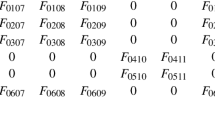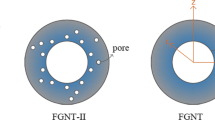Abstract
The second-order coupled piezoelectric models based on the multi-scale asymptotic expansion method are developed for the axially and spherically symmetric composites. The governing piezoelectric equations are compactly formulated in cylindrical and spherical coordinates, and the composite domains are assumed to be periodically occupied by the representative cells. The multi-scale asymptotic expansions for the displacement and the electric potential are formally defined and the effective elastic, piezoelectric, and dielectric coefficients are expressed in terms of the microscopic functions defined on the cell domain. Particularly, the cell solutions and the homogenized solutions for the plane axisymmetric and spherically symmetric problem are derived analytically. The corresponding finite element procedure is proposed, in which the Newmark algorithm is applied to construct the computational scheme in the temporal domain. Numerical experiments are carried out to simulate both the static and dynamic asymptotic behavior of the space axisymmetric and the one-dimensional plane axisymmetric structures. It is validated from the numerical examples that the asymptotic models proposed in the current work are effective to capture the macroscopic performance of the piezoelectric structures and the second-order expansions of the solutions is essential for obtaining the correct distributions of the stress and electric displacement.











Similar content being viewed by others
References
Ikeda, T.: Fundamentals of Piezoelectricity. Oxford University Press, Oxford (1990)
Vives, A.A.: Piezoelectric Transducers and Applications. Springer, Berlin (2008)
Yang, J.Z.: An Introduction to the Theory of Piezoelectricity. Springer, Berlin (2015)
Li, Y.D., Lee, K.Y.: Three dimensional axisymmetric problems in piezoelectric media: revisited by a real fundamental solutions based new method. Appl. Math. Model. 36, 6100–6113 (2012)
Allik, H., Hughes, T.J.R.: Finite element method for piezoelectric vibration. Int. J. Numer. Methods Eng. 2, 151–157 (1970)
Adeff, S.E.: Simulation of axisymmetric piezoelectric devices. Appl. Math. Comput. 65, 355–369 (1994)
Dong, H.J., Wang, H.M., Hou, P.F.: The transient responses of piezoelectric hollow cylinders for axisymmetric plane strain problem. Int. J. Solids Struct. 40, 105–123 (2003)
Filoux, E., Calle, S., Lou-Moeller, R., Lethiecq, M., Levassort, F.: 3-D numerical modeling for axisymmetrical piezoelectric structures: application to high-frequency ultrasonic transducers. IEEE. T. Ultrason. Ferr. 57, 1188–1198 (2010)
Yong, Y.K., Cho, Y.: Numerical algorithms for solutions of large eigenvalue problems in piezoelectric resonators. Int. J. Numer. Methods Eng. 39, 909–922 (1996)
Lovane, G., Nasedkin, A.V.: Modal analysis of piezoelectric bodies with voids. I. Mathematical approaches. Appl. Math. Model. 34, 60–71 (2010)
Lovane, G., Nasedkin, A.V.: Modal analysis of piezoelectric bodies with voids. II. Finite element simulation. Appl. Math. Model. 34, 47–59 (2010)
Nowacki, W.: Some general theorems of thermopiezoelectricity. J. Therm. Stress. 1, 171–182 (1978)
Yang, J.S., Batra, R.C.: Free vibration of a linear thermopiezoelectric body. J. Therm. Stress. 18, 247–262 (2015)
Wang, H.M., Ding, H.J., Chen, Y.M.: Dynamic solution of a multilayered orthotropic piezoelectric hollow cylinder for axisymmetric plane strain problems. Int. J. Solids Struct. 42, 85–102 (2005)
Abdel-Gawad, A., Wang, X.D.: An improved model of thin cylindrical piezoelectric layers between isotropic elastic media. Int. J. Solids Struct. 50, 4118–4132 (2013)
Gu, G.Q., Wei, E.B., Xu, C.: Effective elastic properties of piezoelectric composites with radially polarized cylinders. Phys. B 404, 4001–4006 (2009)
Deraemaeker, A., Nasser, H.: Numerical evaluation of the equivalent properties of Macro Fiber Composite (MFC) transducers using periodic homogenization. Int. J. Solids Struct. 47, 3272–3285 (2010)
Bensoussan, A., Lions, J.L., Papanicolaou, G.: Asymptotic Analysis for Periodic Structures. North-Holland, Amsterdam (1978)
Oleinik, O.A., Shamaev, A.S., Yosifian, G.A.: Mathematical Problems in Elasticity and Homogenization. North-Holland, Amsterdam (1992)
Cioranescu, D., Donato, P.: An Introduction to Homogenization. Oxford University Press, New York (1999)
Lions, J.L.: Some Methods in the Mathematical Analysis of Systems and their Control. Science Press, Gordon and Breach, Beijing (1981)
Allaire, G.: Homogenization and two-scale convergence. SIAM J. Math. Anal. 23, 1482–1518 (1992)
Hou, T.Y., Wu, X.H.: A multiscale finite element method for elliptic problems in composite materials and porous media. J. Comput. Phys. 134, 169–189 (1997)
Assyr, A., E, W.N., Björn, E., Eric, V.E.: The heterogeneous multiscale method. Acta Numer. 21, 1–87 (2012)
E, W.N.: Principles of Multiscale Modeling. Science Press, Beijing (2012)
Castillero, J.B., Otero, J.A., Ramos, R.R., Bourgeat, A.: Asymptotic homogenization of laminated piezocomposite materials. Int. J. Solids Struct. 35, 527–541 (1998)
Weller, T., Licht, C.: Asymptotic modeling of thin piezoelectric plates. Ann. Solid Struct. Mech. 1, 173–188 (2010)
Martinez-Ayuso, G., Friswell, M.I., Adhikari, S., Khodaparast, H.H., Berger, H.: Homogenization of porous piezoelectric materials. Int. J. Solids Struct. 113–114, 218–229 (2017)
Sabina, F.J., Rodriguez-Ramos, R., Bravo-Castillero, J., Guinovart-Diaz, R.: Close-form expressions for the effective coefficients of a fibre-reinforced composite with transversely isotropic constituents. II. Piezoelectric and hexagonal symmetry. J. Mech. Phys. Solid 49, 1463–1479 (2001)
Berger, H., Babbert, U., Koppe, H., Rodriguez-Ramos, R., Bravo-Castillero, J., GuinovartDiaz, R., Otero, J.A., Maugin, G.A.: Finite element and asymptotic homogenization methods applied to smart composite materials. Comput. Mech. 33, 61–67 (2003)
Berger, H., Kari, S., Gabbert, U., Rodrigues-Ramos, R., Bravo-Castillero, J., vart-Daiz, R.G.: Calculation of effective coefficients for piezoelectric fiber composites based on a general numerical homogenization technique. Compos. Struct. 71, 397–400 (2005)
Rohan, E., Lukes̆, V.: Homogenization of the fluid-saturated piezoelectric porous media. Int. J. Solids Struct. 147, 110–125 (2018)
Gałka, A., Telega, J.J., Wojnar, R.: Homogenization and thermopiezoelectricity. Mech. Res. Commun. 19(4), 315–324 (1992)
Cook, A.C., Vel, S.S.: Multiscale thermopiezoelectric analysis of laminated plates with integrated piezoelectric fiber composites. Eur. J. Mech. A Solid 40, 11–33 (2013)
Fantoni, F., Bacigalupo, A., Paggi, M.: Multi-field asymptotic homogenization of thermopiezoelectric materials with periodic microstructure. Int. J. Solids Struct. 120, 32–56 (2017)
Sixto-Camacho L. M., Bravo-Castillero J., Brenner R., Cuinovart-D\(\acute{i}\)az R., Mechkour H., Rodr\(\acute{i}\)guez-Ramos R., Sabina F. J.: Asymptotic homogenization of periodic thermo-megneto-electro-elastic heterogeneous media. Comput. Math. Appl. 66, 2056–2074 (2013)
Yang, Y., Lei, C.H., Gao, C.F., Li, J.Y.: Asymptotic homogenization of three-dimensional thermoelectric composites. J. Mech. Phys. Solids 76, 98–126 (2015)
Tsalis, D., Chatzigeorgiou, G., Charalambakis, N.: Homogenization of structures with generalized periodicity. Compos. Part B 43, 2495–2512 (2012)
Chatzgeorgiou, G., Efendiev, Y., Charalambakis, N., Lagoudas, D.C.: Effective thermoelastic properties of composites with periodicity in cylindrical coordinates. Int. J. Solids Struct. 49, 2590–2603 (2012)
Ghergu, M., Griso, G., Mechkour, H., Miara, B.: Homogenization of thin piezoelectric perforated shells. Esaim-Math. Model. Num. 41(5), 875–895 (2007)
Cui, J.Z., Cao, L.Q.: Finite element method based on two-scale asymptotic analysis. Math. Numer. Sin. 1, 89–102 (1998)
Feng, Y.P., Cui, J.Z.: Multi-scale analysis and FE computation for the structure of composite materials with small periodicity configuration under condition of coupled thermoelasticity. Int. J. Numer. Methods Eng. 60, 241–269 (2004)
Yang, Z.H., Cui, J.Z., Wu, Y.T., Wang, Z.Q., Wan, J.J.: Second-order two-scale analysis method for dynamic thermo-mechanical problems in periodic structure. Int. J. Numer. Anal. Model. 12, 144–161 (2015)
Yang, Z.Q., Hao, Z.W., Sun, Y., Li, Y.Z., Dong, H.: Thermo-mechanical analysis of nonlinear heterogeneous materials by second-order reduced asymptotic expansion approach. Int. J. Solids Struct. 178–179, 91–107 (2019)
Zhang, Y., Cao, L.Q., Wong, Y.S.: Multiscale computations for 3D time-dependent Maxwell’s equations in composite materials. SIAM J. Sci. Comput. 32(5), 2560–2583 (2010)
Deng, M.X., Feng, Y.P.: The two-scale finite element method for piezoelectric problem in periodic structure. Appl. Math. Mech. 32, 1525–1540 (2011)
Su, F., Cui, J.Z.: A second-order and two-scale analysis method for the quasi-periodic structure of composite materials. Finite Elem. Anal. Des. 46, 320–327 (2010)
Ma, Q., Cui, J.Z., Li, Z.H., Wang, Z.Q.: Second-order asymptotic algorithm for heat conduction problems of periodic composite materials in curvilinear coordinates. J. Comput. Appl. Math. 306, 87–115 (2016)
Ma, Q., Li, Z.H., Yang, Z.H., Cui, J.Z.: Asymptotic computation for transient heat conduction performance of periodic porous materials in curvilinear coordinates: by the secondorder two-scale method. Math. Methods. Appl. Sci. 40, 5109–5130 (2017)
Ma, Q., Li, Z.H., Cui, J.Z.: Multi-scale asymptotic analysis and computation of the elliptic eigenvalue problems in curvilinear coordinates. Comput. Methods Appl. Mech. Eng. 340, 340–365 (2018)
Ma, Q., Cui, J.Z., Li, Z.H.: Second-order two-scale asymptotic analysis for axisymmetric and spherical symmetric structure with periodic configur1ations. Int. J. Solids Struct. 78–79, 77–100 (2016)
Li, Z.H., Ma, Q., Cui, J.Z.: Second-order two-scale finite element algorithm for dynamic thermo-mechanical coupling problem in symmetric structure. J. Comput. Phys. 314, 712–748 (2016)
Li, Z.H., Ma, Q., Cui, J.Z.: Multi-scale modal analysis for axisymmetric and spherical symmetric structures with periodic configurations. Comput. Methods Appl. Mech. Eng. 317, 1068–1101 (2017)
Dong, H., Cui, J.Z., Nie, Y.F., Yang, Z.H.: Second-order two-scale computational method for nonlinear dynamic thermo-mechanical problems of composites with cylindrical periodicity. Commun. Comput. Phys. 21, 1173–1206 (2017)
Dong, H., Cui, J.Z., Nie, Y.F., Ma, Q., Yang, Z.H.: Multiscale computational method for the thermoelastic problem of composite materials with orthogonal periodic configurations. Appl. Math. Model. 60, 634–660 (2018)
Dong, H., Zheng, X.J., Cui, J.Z., Nie, Y.F., Yang, Z.Q., Ma, Q.: Multi-scale computational method for dynamic themo-mechanical performance of heterogeneous shell structures with orthogonal periodic configurations. Comput. Methods Appl. Mech. Eng. 354, 143–180 (2019)
Acknowledgements
The research is supported by National Natural Science Foundation of China (11801387, 11501389, 11471214), State Key Laboratory of Science and Engineering Computing and the fundamental research funds for the central universities. The first author would like to thank Emily Lee for her useful help on proofreading the problem of language of this paper. The authors are particularly thankful to the reviewers and editor for their valuable comments and suggestions, which greatly improved the quality of the paper.
Author information
Authors and Affiliations
Corresponding authors
Additional information
Publisher's Note
Springer Nature remains neutral with regard to jurisdictional claims in published maps and institutional affiliations.
Appendices
Appendix A: Cell Solutions for the Plane Axisymmetric and Spherically Symmetric Problems
For the plane axisymmetric problem (6), the first-order periodic cell functions \(N_1\), F, M, \(R_1\), H and T satisfy the following boundary value problems
respectively. Based on these problems and the homogenized coefficients in Eq. (40), we have
where
As the polarized piezoelectric constituent materials are not isotropic, it is of few interests to compare the magnitude of the coefficients in different directions as was done in [51,52,53].
Moreover, the explicit solutions of all the first-order cell functions are
respectively, and we also have
By considering these equalities above, the boundary value problems for the second-order cell functions \(N_{11}\), \(H_{11}\), \(\bar{N}_1\) , \(\bar{H}_1\) , \(\bar{M}_1\) , \(\bar{T}\) , \(F_{11}\) , \(H_{11}\) ,\(F_1\) , \(\bar{R}_1\) , \(\bar{P}_1\) and \(\bar{W}\) can be simplified as
respectively. Combining all the first-order cell solutions in Eq. (51) and the homogenized coefficients in Eq. (40), the explicit expressions of all the second-order cell functions can also be obtained successively.
For the second-order correctors of the spherically symmetric problem, the only pair of cell functions that is different from the one in the axisymmetric case is \((\bar{M}_1, \bar{T})\), which satisfies the cell problem in Q as
Appendix B: Homogenized Solutions for the Plane Asixymmetric and Spherically Symmetric Cases
The static plane axisymmetric piezoelectric problem without the source term is written as
Let \(u_1^0=\alpha x_1^k\) and \(\phi = \beta x_1^k\), where \(\alpha \) , \(\beta \) and k are real numbers. Substituting them into the equations in (58), we have
Since the nontrivial solutions are sought, \(\alpha \) and \(\beta \) cannot be both 0. Thus, the determinant of the coefficient matrix above has to vanish, i.e.,
Then
and we obtain the general solution for \(u_1^0\) and \(\phi ^0\) as
Together with the boundary conditions, the unknown \(C_1\) , \(C_2\) , \(C_3\) and \(C_4\) can be determined.
The homogenized static piezoelectric problem with spherical symmetry reads as
By the same argument as the axisymmetric case, we obtain the general solutions written by
where \(V_k = 2{V_0}(\epsilon _1^0({({G_\theta } + {\lambda _\theta })^0} - {\lambda ^0}) - e_\theta ^0(2e_\theta ^0 - e_1^0))\), and \(k_1\) and \(k_2\) are the roots of the following quadratic equation
The unknown constants \(C_1\), \(C_2\), \(C_3\) and \(C_4\) are obtained by applying the boundary conditions.
Rights and permissions
About this article
Cite this article
Ma, Q., Wang, H., Yang, Z. et al. Second-Order Asymptotic Analysis and Computations of Axially and Spherically Symmetric Piezoelectric Problems for Composite Structures. J Sci Comput 81, 689–731 (2019). https://doi.org/10.1007/s10915-019-01041-x
Received:
Revised:
Accepted:
Published:
Issue Date:
DOI: https://doi.org/10.1007/s10915-019-01041-x




